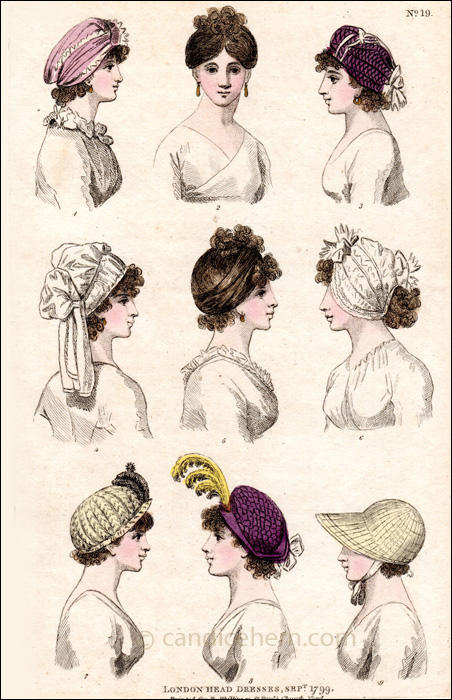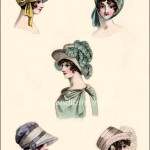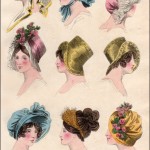Fashions of London and Paris, September 1799.
“London Head Dresses, Sept. 1799.”
 Often in prints of head dresses we are shown hairdos as well, which I always find interesting. It must have been useful for readers to learn the latest ways of styling hair.
Often in prints of head dresses we are shown hairdos as well, which I always find interesting. It must have been useful for readers to learn the latest ways of styling hair.
It is intriguing that Figure 7 is called a porcupine bonnet, as those creatures were indigenous to North America and northern South America, and not at all known in England. The closest thing they have to a porcupine is a hedgehog, and yet here we have a porcupine bonnet. Perhaps it was so called as the piped straw resembled porcupine quills. A interesting bonnet name, in any case.
The print is described in the magazine as follows:
“Fig. 1. Turban of cambrick muslin and purple sattin.
“Fig. 2 The hair combed with bows in front and large curls at top, the neck and ears quite bare.
“Fig. 3. Bonnet of plaited purple and black satin, trimmed with white ribbon.
“Fig. 4. Turban of white muslin, the front is a reverse plaited band, the crown full and finished on one side with a bow and end.
“Fig. 5. The hair banded; short in the neck; low and full on the forehead; a full tuft at top behind the bands.
“Fig. 6. A fashionable and elegant morning cap made of white muslin; three full lace borders, bows of white ribband behind and before.
“Fig. 7. The porcupine bonnet made of pipe straw, raised alternately. A raised ostrich plume in front, and a military plume close to it on the left side.
“Fig. 8. A puckered sattin bonnet with a shaded coque plume. MAde in all colors.
“Fig. 9. The new Grecian shape made of pipe straw and gimp.”







